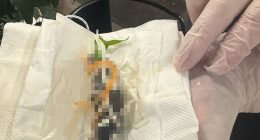It’s often seen as a taboo subject, despite being something that many people do.
But scientists have put any embarrassment about masturbation aside in a new study looking into the origins of the practice.
While previous studies suggested that masturbation was simply a by-product of sexual arousal, the team from UCL claims that the behaviour actually served an evolutionary purpose – at least in men.
Their findings indicate that masturbation evolved in male primates to increase mating success and help to avoid STIs.
However, the scientists admit that when it comes to women, they’re still clueless as to the origins of masturbation.


It’s often seen as a taboo subject, despite being something that many people do. But scientists have put any embarrassment about masturbation aside in a new study looking into the origins of the practice (stock image)
Masturbation isn’t just practiced by humans – it’s common across the animal kingdom, particularly in primates.
However, until now, how and when it became prevalent has remained unclear.
In the new study, the team assembled the largest ever dataset of primate masturbation, including information from nearly 400 sources.
Their analysis of the data revealed that masturbation dates back millions of years and was likely even practiced by the common ancestor of monkeys and humans.
To understand why evolution would promote masturbation, the team tested several theories.
The ‘postcopulatory selection hypothesis’ suggests that self-stimulation improves fertilisation, through various ways.
Firstly, masturbating (without ejaculation) before sex increases arousal – a tactic that may be particularly useful for low-ranking males who are likely to be interrupted during sex, by helping them to ejaculate faster, according to the researchers.
Secondly, masturbation (with ejaculation) lets males shed inferior semen, leaving fresh, high-quality sperm available for mating.
The next hypothesis, called the ‘pathogen avoidance hypothesis’, proposes that masturbation reduces the risk of an STI after sex by cleansing the urethra.
The team found evidence in support of both of these hypotheses.
Read Related Also: Over 200 ‘killer bees’ attack Oklahoma man, 81, for THREE hours after he fell and broke hip
Dr Matilda Brindle, lead author of the study, said: ‘Our findings help shed light on a very common, but little understood, sexual behaviour and represent a significant advance in our understanding of the functions of masturbation.
‘The fact that autosexual behaviour may serve an adaptive function, is ubiquitous throughout the primate order, and is practised by captive and wild-living members of both sexes, demonstrates that masturbation is part of a repertoire of healthy sexual behaviours.’
The team admits that it still doesn’t know how or why female masturbation evolved, but now hopes to analyse further data to understand its role.
The study comes shortly after researchers from the University of Lethbridge revealed how macaques – both male and female – frequently use stone tools as sex toys to pleasure themselves.
The team studied video footage captured of long-tailed macaques in the Sacred Monkey Forest Sanctuary from 2016-2019.
In the videos, they spotted hundreds of examples of monkeys rubbing or tapping stones on their genitals while in a seated position.
The males played with the stones more when their penises were stretched out with one hand or erect, which suggests that the action was for sexual pleasure, according to the researchers.
However, it was harder to understand whether the females were rubbing the stones for sexual pleasure of not.
They tended to choose rougher stones to apply to their genitals, which the researchers suggest could provide greater stimulation than smooth stones.




